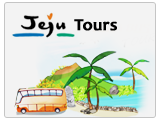SEOUL + JEJU PACKAGE (6D5N)
-
- Tour Period
- Spring ~ Summer Season (March 01, 2018 ~ August 31, 2018)
- Price
- from US$ 660 per Pax※ Price is subject to change based on total pax size.
- Inclusion
- Accommodations (3* Hotels in Seoul + Jeju for 5 Nights)Breakfast (5 Times Breakfasts at Hotel)Return Domestic Flight (Seoul-Jeju-Seoul by local budget flight)Tours & Meals (3 Days for Seoul + 2 Days for Jeju)Private Vehicle ※ SIC Group Tour in JEJU for 4-6 PaxTour GuideAdmission FeesLunch (5) + Dinner (5) ※ Lunch (5) + Dinner (3) for 4-6 Pax
- Exclusion
- Airport Transfers for 4-6 PaxCJU to Jeju HotelGMP to Seoul HotelSeoul Hotel to ICNDinner in Jeju for 4-6 PaxPersonal ExpensesTraveler's InsuranceTip for Guide
Itinerary
-
DAY 1 (Mon)SEOUL - GAPYEONG TOUR - SEOULMeet our Guide at Incheon Airport → Move to Gapyeong [2H] → Lunch → Nami Island → Petit France → Coffee at Café → Dinner → Drop-off at Seoul Hotel.DAY 2 (Tue)SEOUL - YANGPYEONG TOUR - SEOULMeet our Guide → Move to Yangpyeong [1H] → Dumulmeori → Yangpyeong Railbike → Lunch → Strawberry Festival/ Lotus Festival/ Catfish Festival at Green Village → Retro Museum → Dinner → Drop-off at Seoul Hotel.DAY 3 (Wed)SEOUL CITY - JEJUBreakfast & Check-out Hotel - Meet our Guide [09:00am] → Via Cheonggyecheon Stream → Royal Guard Changing Ceremony → Gyeongbokgung Palace → Lunch @ Insadong Ssamjiegil → N Seoul Tower by Cable Car [Observatory is optional] → Experience Gimbap Making & Hanbok Wearing → Namdaemun Market → Drop-off at GIMPO Airport: To JEJU → Arrived at JEJU Airport & Customer’s Own Transfer to Jeju Hotel.DAY 4 (Thu)JEJU TOURBreakfast at Hotel - Meet our Guide → Hyupjae & Gumneung Beach → Hallim Park → Suweolbong Trekking → Lunch → O’sulloc Green Tea Field → Mt. Sanbang → Teddy Bear Museum or Cheonjeyeon Waterfall → Drop-off at Jeju Hotel.DAY 5 (Fri)JEJU TOUR - SEOULBreakfast & Check-out Hotel - Meet our Guide → Horseback Riding → Seongeup Folk Village → Lunch → Seongsan Ilchulbong Peak → Woman Diver Show → Via Jondalri Shore Road → Manjang Cave → Drop-off at JEJU Airport: To SEOUL → Arrived at GIMPO Airport & Customer’s Own Transfer to Seoul Hotel.DAY 6 (Sat)SEOUL - ICNBreakfast & Check-out Hotel → Free at Own Leisure → Customer’s Own Transfer to INCHEON Airport.
Highlights
-
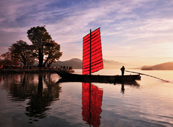 DumulmeoriDumulmeori literally means 'two water area,' and refers to the place where Bukhangang River and Namhangang River meet. The dock for an ancient-style ferry and weeping willows add to the rustic beauty of this area. Another attraction at this site is the three 400-year-old Zelkova trees that appear as one giant tree. A privately owned place, Dumulmeori remains as a popular site for shooting Korean TV dramas, movies, commercials, wedding pictures as well as nature pictures.
DumulmeoriDumulmeori literally means 'two water area,' and refers to the place where Bukhangang River and Namhangang River meet. The dock for an ancient-style ferry and weeping willows add to the rustic beauty of this area. Another attraction at this site is the three 400-year-old Zelkova trees that appear as one giant tree. A privately owned place, Dumulmeori remains as a popular site for shooting Korean TV dramas, movies, commercials, wedding pictures as well as nature pictures.
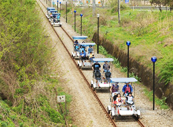 Yangpyeong RailbikeUsing a long abandoned railway, the Yangpyeong Rail Bike offers a unique bike ride at speeds of 15km/h from Yongmun to Wondeok. This 3.2km journey passes along a gleaming river and tree covered mountains. The bike ride delivers picturesque scenery all year round.
Yangpyeong RailbikeUsing a long abandoned railway, the Yangpyeong Rail Bike offers a unique bike ride at speeds of 15km/h from Yongmun to Wondeok. This 3.2km journey passes along a gleaming river and tree covered mountains. The bike ride delivers picturesque scenery all year round.
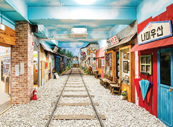 Retro MuseumRetro Museum is definitely a different museum, just like the name "Retro". If you are familiar with Trick Eye Museum (basically it's a fun place that gives visitors opportunity to actually become a part of the art on display), Retro Museum is the newest trick eye museum located in Yangpyeong, Gyeonggi-do and opened its doors in July 2016. What makes this museum different with the most trick eye museum is this museum offers a nostalgic journey for those who grew up during 1970~1980s and it shows amazing historic experience to younger generation.
Retro MuseumRetro Museum is definitely a different museum, just like the name "Retro". If you are familiar with Trick Eye Museum (basically it's a fun place that gives visitors opportunity to actually become a part of the art on display), Retro Museum is the newest trick eye museum located in Yangpyeong, Gyeonggi-do and opened its doors in July 2016. What makes this museum different with the most trick eye museum is this museum offers a nostalgic journey for those who grew up during 1970~1980s and it shows amazing historic experience to younger generation.
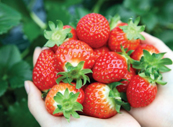 Strawberry FestivalKorean strawberries are famous for being SWEET! You can experience for strawberry picking in Korea every year from December to May, and there are not only strawberry picking but also a variety experiences are waiting for you such as making jam and choco dipping. It will be a lovely experience in the nature with yummy strawberries!
Strawberry FestivalKorean strawberries are famous for being SWEET! You can experience for strawberry picking in Korea every year from December to May, and there are not only strawberry picking but also a variety experiences are waiting for you such as making jam and choco dipping. It will be a lovely experience in the nature with yummy strawberries!
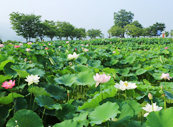 Lotus FestivalTaking a walk along ponds full of lotus flowers is one of the must-do during summer in Korea. During lotus festival, you can get to observe elegant lotus flowers both by day and by night at Semiwon in Yangpyeong-gun. Semiwon is the park was designed with paths made out of washboards and is decorated with lotus-themed poetry and drawings. Wherever you look and wherever you go, you will be surrounded by water and flowers at Semiwon.
Lotus FestivalTaking a walk along ponds full of lotus flowers is one of the must-do during summer in Korea. During lotus festival, you can get to observe elegant lotus flowers both by day and by night at Semiwon in Yangpyeong-gun. Semiwon is the park was designed with paths made out of washboards and is decorated with lotus-themed poetry and drawings. Wherever you look and wherever you go, you will be surrounded by water and flowers at Semiwon.
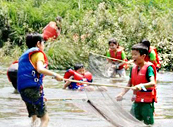 Catfish FestivalCatfish Festival is being held in Soomi Village of Yangpyeong-gun under the theme of Exciting Summer Camp. Features of the program include catching loach and catfish by hand, Doksal (catching fish by forming a stonewall puddle in the stream), riding a wooden raft, and playing with water cannons or guns. Visitors who catch fish in the stream can cook it themselves or have the villagers make fish porridge with it for the visitors.
Catfish FestivalCatfish Festival is being held in Soomi Village of Yangpyeong-gun under the theme of Exciting Summer Camp. Features of the program include catching loach and catfish by hand, Doksal (catching fish by forming a stonewall puddle in the stream), riding a wooden raft, and playing with water cannons or guns. Visitors who catch fish in the stream can cook it themselves or have the villagers make fish porridge with it for the visitors.
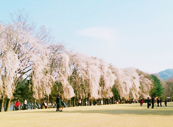 Nami IslandCovered with more than 300 species of trees, the Nami Island had long been frequented by those who appreciate its serene and idyllic setting, but when the drama "Winter Sonata" became a mega-hit in Japan, Japanese tourists flocked there to walk amid the same scenes as the drama's stars Bae Yong-joon and Choi Ji-woo. The Nami Island is not as big as one might expect, but cozy and versatile. Passing behind the well-known sculpture of a woman waiting in the lake at the main gate, people are ushered onto the grassy island that boasts a tranquil environment rich in biodiversity. For those who want to enjoy nature in an idyllic setting, the highlight of the island is the many tree-lined paths that all lead to the central square's restaurants and shops. The birch tree lined path is better known among drama lovers as the path where Bae and Choi rode a bicycle on their date. You will also see the fragrant pine tree path and spectacular tunnel of tall meta-sequoia trees.
Nami IslandCovered with more than 300 species of trees, the Nami Island had long been frequented by those who appreciate its serene and idyllic setting, but when the drama "Winter Sonata" became a mega-hit in Japan, Japanese tourists flocked there to walk amid the same scenes as the drama's stars Bae Yong-joon and Choi Ji-woo. The Nami Island is not as big as one might expect, but cozy and versatile. Passing behind the well-known sculpture of a woman waiting in the lake at the main gate, people are ushered onto the grassy island that boasts a tranquil environment rich in biodiversity. For those who want to enjoy nature in an idyllic setting, the highlight of the island is the many tree-lined paths that all lead to the central square's restaurants and shops. The birch tree lined path is better known among drama lovers as the path where Bae and Choi rode a bicycle on their date. You will also see the fragrant pine tree path and spectacular tunnel of tall meta-sequoia trees.
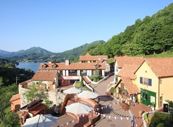 Petit FranceThe concept of Petite France encapsulates 'flowers, stars, and the Little Prince. The village contains a memorial hall dedicated to Saint-Exupery, the author of the celebrated French novel, Le Petit Prince (1943) and as such it is called the Little Prince theme park. It also has a gallery displaying sculptures and paintings of le coq gaulois (the Gallic rooster), the national symbol of France; Orgel House where a 200-year-old music box plays a sweet melody; a shop that sells herbal and aromatic products; a souvenir shop; and many other locales where you can experience French culture. Enjoy the marionette experience and hear percussion instruments from around the world, and also enjoy soap bubble experience.
Petit FranceThe concept of Petite France encapsulates 'flowers, stars, and the Little Prince. The village contains a memorial hall dedicated to Saint-Exupery, the author of the celebrated French novel, Le Petit Prince (1943) and as such it is called the Little Prince theme park. It also has a gallery displaying sculptures and paintings of le coq gaulois (the Gallic rooster), the national symbol of France; Orgel House where a 200-year-old music box plays a sweet melody; a shop that sells herbal and aromatic products; a souvenir shop; and many other locales where you can experience French culture. Enjoy the marionette experience and hear percussion instruments from around the world, and also enjoy soap bubble experience.
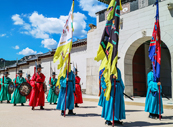 Royal Guard Changing CeremonyIn ancient times the royal guards of Joseon Dynasty performed the given task by guarding the Gwanghwamun Gate the entrance of Gyeongbokgung Palace. The gate guardsmen perform the changing of the guards and hold a parade. The guards, uniforms, weapons and accessories as well as their strict ceremonial procedures catch the eyes of people especially foreign tourists when guardsmen perform the changing of guards in traditional costumes at the main gate of Gyeongbokgung Palace in downtown Seoul.
Royal Guard Changing CeremonyIn ancient times the royal guards of Joseon Dynasty performed the given task by guarding the Gwanghwamun Gate the entrance of Gyeongbokgung Palace. The gate guardsmen perform the changing of the guards and hold a parade. The guards, uniforms, weapons and accessories as well as their strict ceremonial procedures catch the eyes of people especially foreign tourists when guardsmen perform the changing of guards in traditional costumes at the main gate of Gyeongbokgung Palace in downtown Seoul.
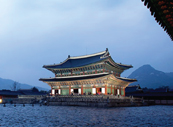 Gyeongbokgung PalaceBuilt in 1395, Gyeongbokgung Palace is also commonly referred to as the Northern Palace because its location is furthest north when compared to the neighboring palaces of Changdeokgung (Eastern Palace) and Gyeonghuigung (Western Palace) Palace. Gyeongbokgung Palace is arguably the most beautiful, and remains the largest of all five palaces. Remarkably, the most representative edifices of the Joseon Dynasty, Gyeonghoeru Pavilion and Hyangwonjeong Pond have remained relatively intact. Woldae and the sculptures of Geunjeongjeon (The Royal Audience Chamber) represent past sculptures of contemporary art.
Gyeongbokgung PalaceBuilt in 1395, Gyeongbokgung Palace is also commonly referred to as the Northern Palace because its location is furthest north when compared to the neighboring palaces of Changdeokgung (Eastern Palace) and Gyeonghuigung (Western Palace) Palace. Gyeongbokgung Palace is arguably the most beautiful, and remains the largest of all five palaces. Remarkably, the most representative edifices of the Joseon Dynasty, Gyeonghoeru Pavilion and Hyangwonjeong Pond have remained relatively intact. Woldae and the sculptures of Geunjeongjeon (The Royal Audience Chamber) represent past sculptures of contemporary art.
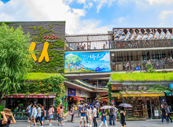 Insadong SsamzigilSsamzigil, opened on December 18, 2004, has been called the "Special Insa-dong within Insa-dong." This unique area was designed in such a way as to connect each charming level together in the form of a spiraling walkway. Enjoy window-shopping in the cozy stores until you reach the top, where you will arrive at Sky Garden. Here, you can get a extraordinarily clear view of the sky.
Insadong SsamzigilSsamzigil, opened on December 18, 2004, has been called the "Special Insa-dong within Insa-dong." This unique area was designed in such a way as to connect each charming level together in the form of a spiraling walkway. Enjoy window-shopping in the cozy stores until you reach the top, where you will arrive at Sky Garden. Here, you can get a extraordinarily clear view of the sky.
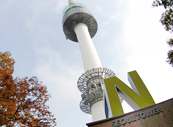 N Seoul TowerNamsan Seoul Tower was built in 1969 as Korea's first integrated transmission tower beaming television and radio broadcasts across the capital. Since opening to the public in 1980, it has become a much-loved Seoul landmark. The tower's main attractions include multi-colored digital art projected onto the tower at night, a digital observatory, a roof terrace, and restaurants. Situated on top of the N Plaza, the Roof Terrace is a spacious wooden viewing deck whose exotic atmosphere makes it very popular with lovers. A recent attraction for courting couples is "Locks of Love," thousands of padlocks attached to the fence by romantic Seoulites symbolizing their undying affection.
N Seoul TowerNamsan Seoul Tower was built in 1969 as Korea's first integrated transmission tower beaming television and radio broadcasts across the capital. Since opening to the public in 1980, it has become a much-loved Seoul landmark. The tower's main attractions include multi-colored digital art projected onto the tower at night, a digital observatory, a roof terrace, and restaurants. Situated on top of the N Plaza, the Roof Terrace is a spacious wooden viewing deck whose exotic atmosphere makes it very popular with lovers. A recent attraction for courting couples is "Locks of Love," thousands of padlocks attached to the fence by romantic Seoulites symbolizing their undying affection.
 Making Gimbap & Wearing HanbokGimbap is a Korean dish made from cooked rice and other ingredients that are rolled in gim (dried sheets of laver seaweed) and served in bite-size slices. The dish is often part of a packed meal, or dosirak, to be eaten at picnics and outdoor events, and can serve as a light lunch along with danmuji (yellow pickled radish) and kimchi.Hanbok is the traditional attire of the Korean people. While the traditional hanbok was beautiful in its own right, the design has changed slowly but surely over the generations. The core of hanbok is its graceful shape and vibrant colors, which have had a major impact on the modern fashion industry.
Making Gimbap & Wearing HanbokGimbap is a Korean dish made from cooked rice and other ingredients that are rolled in gim (dried sheets of laver seaweed) and served in bite-size slices. The dish is often part of a packed meal, or dosirak, to be eaten at picnics and outdoor events, and can serve as a light lunch along with danmuji (yellow pickled radish) and kimchi.Hanbok is the traditional attire of the Korean people. While the traditional hanbok was beautiful in its own right, the design has changed slowly but surely over the generations. The core of hanbok is its graceful shape and vibrant colors, which have had a major impact on the modern fashion industry.
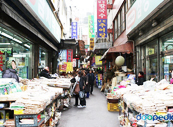 Namdaemun MarketNamdaemun Market is the largest traditional market in Korea with over 10,000 stores that line the streets around Namdaemun (Gate), the main southern gate of the old city wall. It boasts one of the largest distribution structures in Korea, providing local products, daily living essentials, food products, medical supplies and more to retailers and consumers across the country. Namdaemun Market is also packed with interesting things to see and eat, making it a popular destination for both locals and international visitors alike.
Namdaemun MarketNamdaemun Market is the largest traditional market in Korea with over 10,000 stores that line the streets around Namdaemun (Gate), the main southern gate of the old city wall. It boasts one of the largest distribution structures in Korea, providing local products, daily living essentials, food products, medical supplies and more to retailers and consumers across the country. Namdaemun Market is also packed with interesting things to see and eat, making it a popular destination for both locals and international visitors alike.
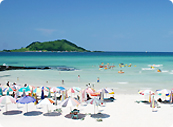 Hyupjae & Gumneung BeachHyupjae Beach is one of the popular places that many tourists visit in anytime. The white sand beach has extra fine sand mixed with shells that glitters with silver, and the emerald-colored water is crystal clear. Also one of well-known island ‘Biyang do -flown island’ can be seen from Hyupjae beach.
Hyupjae & Gumneung BeachHyupjae Beach is one of the popular places that many tourists visit in anytime. The white sand beach has extra fine sand mixed with shells that glitters with silver, and the emerald-colored water is crystal clear. Also one of well-known island ‘Biyang do -flown island’ can be seen from Hyupjae beach.
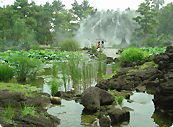 Hallim ParkHallim Park, located western 33km away from Jeju City and west of Mt. Hallasan along the beach in Hallimeup, is one of the most popular tourist spots on Jeju Island. Hallim Park, almost 100 thousand square meters, has a variety of gardens that can be enjoyed in any season. Visitors can enjoy checking out Palm Tree Road, Jeju Stone and Bonsai Garden, Water Garden, Subtropical Botanic Garden and much more. The most famous tourist sites in Hallim Park are Hyeopjaegul and Ssangyonggul Caves known to be the only two-dimensional caves in the world. In addition, a folk village, children's amusement park and outdoor resort facilities make it enjoyable for both children and adults.
Hallim ParkHallim Park, located western 33km away from Jeju City and west of Mt. Hallasan along the beach in Hallimeup, is one of the most popular tourist spots on Jeju Island. Hallim Park, almost 100 thousand square meters, has a variety of gardens that can be enjoyed in any season. Visitors can enjoy checking out Palm Tree Road, Jeju Stone and Bonsai Garden, Water Garden, Subtropical Botanic Garden and much more. The most famous tourist sites in Hallim Park are Hyeopjaegul and Ssangyonggul Caves known to be the only two-dimensional caves in the world. In addition, a folk village, children's amusement park and outdoor resort facilities make it enjoyable for both children and adults.
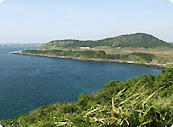 Suweolbong TrekkingMany people find that the sunset here is comparable to Sarabong. From the top of Suweolbong, you can see Chagwi Island, Dansan, Jukdo Islet, and even Songak Mountain with a telescope. Suweolbong has a legend about a brother and a sister who were devoted to their parents. The legend has it that Noko and Suweol, brother and sister, were looking for 100 kinds of medical herbs for their sick mother. After rummaging everywhere, they finally found all of the herbs but one, the root bark of various araliaceous shrubs. They learned that the plant grew on the cliff of Suweolbong. So, Suweol climbed up the cliff and picked the herb.
Suweolbong TrekkingMany people find that the sunset here is comparable to Sarabong. From the top of Suweolbong, you can see Chagwi Island, Dansan, Jukdo Islet, and even Songak Mountain with a telescope. Suweolbong has a legend about a brother and a sister who were devoted to their parents. The legend has it that Noko and Suweol, brother and sister, were looking for 100 kinds of medical herbs for their sick mother. After rummaging everywhere, they finally found all of the herbs but one, the root bark of various araliaceous shrubs. They learned that the plant grew on the cliff of Suweolbong. So, Suweol climbed up the cliff and picked the herb.
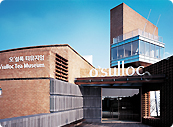 O’sulloc Green Tea FieldThe o'sulloc Museum teaches visitors about Korea's traditional tea culture. The “o“ in “o'sulloc“, means to appreciate and enjoy, and it also stands for the origin of sulloc, only sulloc, and of sulloc tea. The museum, which first opened in September 2001,is widely known in Korea. The entire building takes the shape of a green tea cup. It seeks to harmonize the cultures of the West and East, and past traditions with the modern world. At the O'sulloc Museum, not only can visitors enjoy unique o'sulloc teas, but they can relax next to the lotus pond in the indoor garden. The second floor of the building has an observatory, so visitors can enjoy the views of the nearby green tea fields and the surrounding landscape.
O’sulloc Green Tea FieldThe o'sulloc Museum teaches visitors about Korea's traditional tea culture. The “o“ in “o'sulloc“, means to appreciate and enjoy, and it also stands for the origin of sulloc, only sulloc, and of sulloc tea. The museum, which first opened in September 2001,is widely known in Korea. The entire building takes the shape of a green tea cup. It seeks to harmonize the cultures of the West and East, and past traditions with the modern world. At the O'sulloc Museum, not only can visitors enjoy unique o'sulloc teas, but they can relax next to the lotus pond in the indoor garden. The second floor of the building has an observatory, so visitors can enjoy the views of the nearby green tea fields and the surrounding landscape.
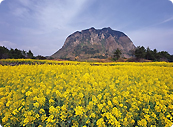 Mt. SanbangSanbangsan Mountain is the result of violent volcanic activity some 700,000 to 800,000 years ago and is in fact a huge body of lava. The cliffs on the southern side of the lava dome are marked with a rich variety of curious formations such as weathering pits and talus scree slopes, some of which are as high as 200m. As its name 'sanbang' – literally meaning 'a cave inside a mountain' – suggests, this mountain contains a cave, which is located about 150m above sea level and has a spectacular view out over the ocean. Due to its close location to the sea and its high elevation, the peak is often ringed with clouds. The upper slopes of the mountain have their own distinct climatic conditions and are protected for their value for botanical research.
Mt. SanbangSanbangsan Mountain is the result of violent volcanic activity some 700,000 to 800,000 years ago and is in fact a huge body of lava. The cliffs on the southern side of the lava dome are marked with a rich variety of curious formations such as weathering pits and talus scree slopes, some of which are as high as 200m. As its name 'sanbang' – literally meaning 'a cave inside a mountain' – suggests, this mountain contains a cave, which is located about 150m above sea level and has a spectacular view out over the ocean. Due to its close location to the sea and its high elevation, the peak is often ringed with clouds. The upper slopes of the mountain have their own distinct climatic conditions and are protected for their value for botanical research.
 Teddy Bear MuseumTeddy Bear Museum offers a lot of interesting things to see with various themes such as history and art of Seoul and a tour around the world, in addition to teddy bear's history of more than 100 years. Displayed Teddy bears are handmade by designers with premium goat wool for high quality. There are other teddy bear-relatedproducts available.
Teddy Bear MuseumTeddy Bear Museum offers a lot of interesting things to see with various themes such as history and art of Seoul and a tour around the world, in addition to teddy bear's history of more than 100 years. Displayed Teddy bears are handmade by designers with premium goat wool for high quality. There are other teddy bear-relatedproducts available.
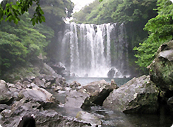 Cheonjeyeon WaterfallAccording to a legend, Cheonjeyon Falls means “the pond of God” where nymphs descend to take a bath. The first cascade of Cheonjeyon Waterfall is 22 m high and the water forms a pond 21 m in depth. The water flows farther along to form the second cascade of 30 m high. Up from Cheonjeyon Falls is the stunning arch bridge Seonimkyo, which is also called Seven Nymphs Bridge. Water springs from a spot between the precipice of the waterfall and the lower clay layer. From the ceiling of a cave located east of the first waterfall, the water drops and grows into several streams of water. Since it is gushing out of stony ground, the water has been used for curing diseases as well as for drinking. From ancient times, people have believed that they can recover from any disease if they stand under a waterfall on either the Buddhist All Souls Day or Cheoseo Day (at the end of August). Right next to the falls is Yeomiji Botanical Gardens and many other tourist attractions.
Cheonjeyeon WaterfallAccording to a legend, Cheonjeyon Falls means “the pond of God” where nymphs descend to take a bath. The first cascade of Cheonjeyon Waterfall is 22 m high and the water forms a pond 21 m in depth. The water flows farther along to form the second cascade of 30 m high. Up from Cheonjeyon Falls is the stunning arch bridge Seonimkyo, which is also called Seven Nymphs Bridge. Water springs from a spot between the precipice of the waterfall and the lower clay layer. From the ceiling of a cave located east of the first waterfall, the water drops and grows into several streams of water. Since it is gushing out of stony ground, the water has been used for curing diseases as well as for drinking. From ancient times, people have believed that they can recover from any disease if they stand under a waterfall on either the Buddhist All Souls Day or Cheoseo Day (at the end of August). Right next to the falls is Yeomiji Botanical Gardens and many other tourist attractions.
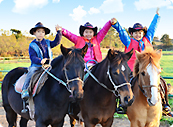 Horseback RidingHorses can be seen all around Jeju island. Horses were the most preferred gifts to be presented to the King from Jeju because the island was popularly called “the pasturage of horses”. Horse riding on a Jeju trip is something that should not be missed. The horses used for riding are known as Jejusanma and are of mixed breeds. Experiencing actual horse riding will make you feel closer to horses.
Horseback RidingHorses can be seen all around Jeju island. Horses were the most preferred gifts to be presented to the King from Jeju because the island was popularly called “the pasturage of horses”. Horse riding on a Jeju trip is something that should not be missed. The horses used for riding are known as Jejusanma and are of mixed breeds. Experiencing actual horse riding will make you feel closer to horses.
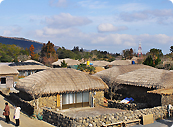 Seongeup Folk VillageLocated at the foot of Mt. Halla on Jeju Island, Seongeup Folk Village is a small town that holds a vast amount of culture. Cultural properties in the folk village have been handed down from generation to generation and include treasures such as residential houses, Confucian shrines and schools, ancient government offices, stone statues, large millstones (pulled by horses or ox), fortress ruins, and stone monuments. Among the cultural gems of the folk village are intangible cultural assets such as folk plays, native foods, local folk craftsmanship, and local dialect. Even the trees are an important part of the area's heritage. Several zelkova and nettle trees that are hundreds of years old stand at the center of the village, preserving the dignified atmosphere of a bygone era. The Seongeup Folk Village shows the unique culture of Jeju Island: the black lava rock walls, the straight but curvy alleys to block the wind, and the stone grandfather statues (Harubang), which have become a prime feature of the landscape. The local black-haired pigs and tongsi (pigsty / restroom) are especially well-known characteristics of Jeju folk culture. The Jeju black pork is said to be very nutritious.
Seongeup Folk VillageLocated at the foot of Mt. Halla on Jeju Island, Seongeup Folk Village is a small town that holds a vast amount of culture. Cultural properties in the folk village have been handed down from generation to generation and include treasures such as residential houses, Confucian shrines and schools, ancient government offices, stone statues, large millstones (pulled by horses or ox), fortress ruins, and stone monuments. Among the cultural gems of the folk village are intangible cultural assets such as folk plays, native foods, local folk craftsmanship, and local dialect. Even the trees are an important part of the area's heritage. Several zelkova and nettle trees that are hundreds of years old stand at the center of the village, preserving the dignified atmosphere of a bygone era. The Seongeup Folk Village shows the unique culture of Jeju Island: the black lava rock walls, the straight but curvy alleys to block the wind, and the stone grandfather statues (Harubang), which have become a prime feature of the landscape. The local black-haired pigs and tongsi (pigsty / restroom) are especially well-known characteristics of Jeju folk culture. The Jeju black pork is said to be very nutritious.
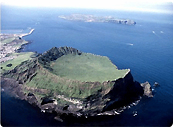 Seongsan Ilchulbong PeakSeongsan Ilchulbong Peak rose from under the sea in a volcanic eruption over 100,000 years ago. Located on the eastern end of Jejudo Island, there is a huge crater at the top of Seongsan Ilchulbong Peak. The crater is about 600m in diameter and 90m high. With the 99 sharp rocks surrounding the crater, it looks like a gigantic crown. While the southeast and north sides are cliffs, the northwest side is a verdant grassy hill that is connected to the Seongsan Village. The ridge provides an ideal spot for walks and for horse riding as well. The sunrise from the crater is magnificent. Also the Seongsan Ilchulbong Peak surrounded by bright yellow colored rapeseed flowers in the spring is truly a sight to behold.
Seongsan Ilchulbong PeakSeongsan Ilchulbong Peak rose from under the sea in a volcanic eruption over 100,000 years ago. Located on the eastern end of Jejudo Island, there is a huge crater at the top of Seongsan Ilchulbong Peak. The crater is about 600m in diameter and 90m high. With the 99 sharp rocks surrounding the crater, it looks like a gigantic crown. While the southeast and north sides are cliffs, the northwest side is a verdant grassy hill that is connected to the Seongsan Village. The ridge provides an ideal spot for walks and for horse riding as well. The sunrise from the crater is magnificent. Also the Seongsan Ilchulbong Peak surrounded by bright yellow colored rapeseed flowers in the spring is truly a sight to behold.
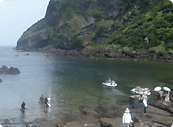 Woman Diver ShowWomen divers, one of distinctive symbols of Jeju, dressed in black rubber driving suits, have been fighting the cold water waves of the sea. You could see them with your own eyes, taste fresh seafood they catch, and take pictures with them.
Woman Diver ShowWomen divers, one of distinctive symbols of Jeju, dressed in black rubber driving suits, have been fighting the cold water waves of the sea. You could see them with your own eyes, taste fresh seafood they catch, and take pictures with them.
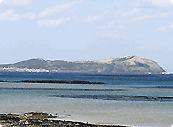 Via Jondalri Shore RoadThe tour bus takes beautiful coastline of Jeju. Whilst heading to Manjang cave, you can appreciate the beauty of Jeju's Ocean.
Via Jondalri Shore RoadThe tour bus takes beautiful coastline of Jeju. Whilst heading to Manjang cave, you can appreciate the beauty of Jeju's Ocean.
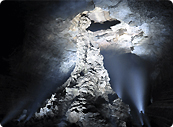 Manjang CaveManjanggul Cave (만장굴) is one of the finest lava tunnels in the world, and is a designated natural monument. A lava tunnel is formed when the lava that was deep in the ground spouts from the peak and flows to the surface. Manjanggul Cave has a variety of interesting structures inside including 70cm lava stalagmites and the lava tube tunnels. Only 1km of the 13,422m Manjanggul Cave is open to the tourists. The inside of the tunnel sustains at a temperature of 11~21℃, creating a comfortable atmosphere. There are rare animals such as bats living in the tunnel, which makes this tunnel valuable for researchers as well. The stone pillars and stalactites are widely spread and the tunnels shows off the cave's topographical features. The Stone Turtle is especially eye-catching because it is shaped like Jeju-do Island.
Manjang CaveManjanggul Cave (만장굴) is one of the finest lava tunnels in the world, and is a designated natural monument. A lava tunnel is formed when the lava that was deep in the ground spouts from the peak and flows to the surface. Manjanggul Cave has a variety of interesting structures inside including 70cm lava stalagmites and the lava tube tunnels. Only 1km of the 13,422m Manjanggul Cave is open to the tourists. The inside of the tunnel sustains at a temperature of 11~21℃, creating a comfortable atmosphere. There are rare animals such as bats living in the tunnel, which makes this tunnel valuable for researchers as well. The stone pillars and stalactites are widely spread and the tunnels shows off the cave's topographical features. The Stone Turtle is especially eye-catching because it is shaped like Jeju-do Island.
Terms & Conditions
-
- Hotel Accommodations
- - Accommodations are based on TWIN-SHARING occupancy at D7 SUITES in SEOUL + AMBER HOTEL in JEJU or similar.
- - Complimentary Breakfast will be provided.
- Domestic Flight
- - Domestick ticket by local budget flight will be provided for round trip between Seoul and Jeju Island.
- - The specific flight schedule will be confirmed upon your online booking.
- Airport Transfers
- - Airport transfers below shall be customer's own for the total pax size of 4-6 people.CJU to Jeju Hotel / GMP to Seoul Hotel / Seoul Hotel to ICN.
- - All necessary airport transfers will be provided for total pax size more than 7 people.
- Tours & Meals
- - We have seasonal festivals for YANGPYEONG TOUR, and it shall be decided on the spot of the tour based on its availability at that time.
- - Please choose one either Teddy Bear Museum or Cheonjeyeon Waterfall during Jeju Tour on Day 04.
- - There is no tour provided in Seoul on Day 06, and it will be customer's own leisure until the time for airport transfer.
- - About Jeju Tours, the type of transportation will be different based on total pax size as following;Private Tour : Total pax size more than 7 people.SIC Group Tour : Total pax size for 4-6 people
- - The menu of lunch and dinner would be as following;Lunch : Steamed Rice Wrapped in a Lotus Leaf, Chicken BBQ, Bibimbap, Korean-style Buffet, Pork Bulgogi or similar.Dinner : Chicken Soup, Beef Bulgogi Rice, Korean Noodles, Braised Chicken or similar.
- - The dinner during Jeju Tours are not providing for total pax size of 4-6 people.
- Range of Responsibility
- - We disclaim all the responsibility for accident or lost due to your carelessness.
- - Travel Insurance applies to the accident of vehicle traffic only, and the settlement of traffic accidents would be done according to the Policy of Insurance Company.
- - If at any time after successfully booked your tour and the Tour Schedule unexpectedly has been changed due to circumstances which we reasonably consider to be beyond our control or reasons of safety, we shall at our option, either: a) carry you on the same Tour on the next available date; or b) refund you the Paid Amount and we shall have no further liability to you.
- - If the time during your tour and the Tour Schedule unexpectedly has been changed due to circumstances which we reasonably consider to be beyond our control or reasons of safety, we shall at our option, either: a) carry you on the similar type of Alternative Attractions; or b) refund you the Admission Fee for the attractions which we can't visit and we shall have no further liability to you.
Price Policy
-
- Price is quoted in USD per Person basis.
- Payment Method: Please choose the payment method among Credit Card, Bank Transaction, and Cash Payment when you make online reservation.
- The Charges for Cancellation or No-Show shall be settled by Credit Card at the time it's happened.
- US$ 50 per Pax for Domestic Flight during Weekend (Fri~Sun) / US$ 150 per Pax for Single Participant.
- Child Fares: Free of charge for less than 2 years old and 10% DC for 2-6 years old.
Booking & Cancellation
-
- Bookings
- - This PACKAGES will be available from March 01, 2018 until August 31, 2018.
- - Reservations should be made 10 Days prior to your expected tour date to secure the booking properly.
- Cancellation Charges





 E-mail
E-mail
